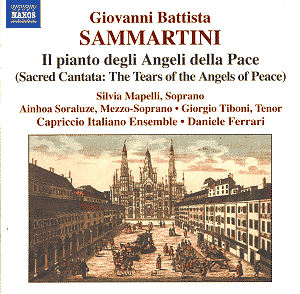This recording of Sammartini’s
sacred cantata is billed as a world première. This version is based on a
critical edition prepared by the conductor Daniele Ferrari. The title
translates as The Tears of the Angels of Peace and there is a subtitle –
Angels of Alliance, of the Testament and of Grace
reflecting the roles of the three soloists, each of whom has one major aria.
These three arias form the core of the work. It opens with a brief orchestral
Sinfonia following which the three soloists combine to give the first of three
renditions of Amare lagrime (Bitter tears flow forth in rivers). After
recitatives sung by the tenor and mezzo-soprano interspersed with a prompt
reprise of Amare lagrime, the Angel of Alliance sings Oscurata impallidita
describing the “obscured and pallid” life “that was so dear to heaven” but
which “fell victim and became the sacrifical altar”. The Angel of the Testament
takes over with a linking recitative followed by the aria Rasserenate il ciglio
(Dry your eyes). By the end of this, tears are flowing once again (And, moved
by Pity, may you weep once more). The Angel of Grace tells the others to go
whilst remaining to “watch over the beastly implements of death”. The ensuing
aria Dal profondo de’ squallidi Abissi (I see spite, deceit, threats,
death) leads to the brief recitatives with the “punch lines” – “Beneath the
Tree one Man lay dead” … and “by means of the Tree Man won out and was reborn”.
The work concludes with a second reprise of Amare lagrime. From the
documentation it is not clear to me, and may not be known, who wrote the text.
The back of the booklet seems to reproduce part of a programme dated 1751
(perhaps from the first performance?) which attributes the music to Sammartini
in quite small print but does not seem to credit the author of the text.
With the exception of the final
recitative quoted above, the words of this cantata are almost unremittingly
bleak. Sammartini’s music is much less so and seems to provide elements of hope
throughout. The musical world moved on a considerable distance during his long
career and, in this middle period work, elements of the classical style were
emerging. The Italian origins are always clear and influence of Vivaldi often
detectable. Nevertheless this is a work of an original and imaginative mind.
The orchestra is a prominent contributor although textures are light. Overall,
the setting seems rather restrained. The repeated terzetto, Amare lagrime,
is most memorable: bitter-sweet, beautiful and superbly realized here. All
three soloists excel in their arias and the players of Capriccio Italiano
Ensemble are clearly in their element. Daniele Ferrari directs a performance
which sets the bar very high for any future recorded competition.
Sammartini wrote much orchestral
music during his various posts as maestro di capella in Milan. It seems
probable that only a selection survives but about sixty symphonies are known.
The work in E flat played here is an attractive filler in three short
movements. The style seems to me have some similarity with the work of Johann
Christian Bach.
The recorded sound is excellent
and, at bargain price, this is tremendous value. Documentation includes a
useful essay and the text of the cantata in Italian and English. Sammartini has
not been entirely neglected on record but has perhaps not yet gained the
recognition that seems to be his due. Hopefully this record will be a big step
forward in that respect.
More than 250 years after it was
written, the music of the cantata Il pianto degli Angeli della Pace
still has a lot to say. Presumably heard by relatively few people in recent
times, it is ripe for rediscovery. Apparently Naxos has another première
recording of one of Sammartini’s sacred cantatas on the way – that is already
on my wish list for 2005.
Patrick C Waller
see also Review
by Jonathan Woolf

![]() Ainhoa Soraluze (mezzo-soprano)
Angel of Alliance
Ainhoa Soraluze (mezzo-soprano)
Angel of Alliance![]() NAXOS 8.557432
[54:09]
NAXOS 8.557432
[54:09]





